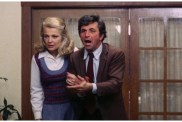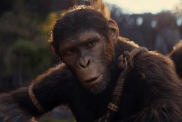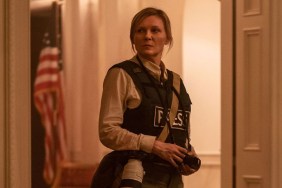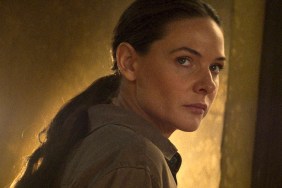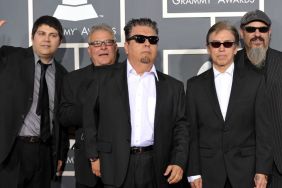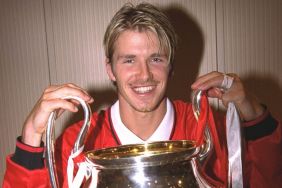Actor Stuart Townsend has starred in a number of different kinds of films over the years as well as the updated television version of “Night Stalker,” but when he decided to make his first feature, he took on the ambitious project Battle in Seattle, bringing together a diverse group of actors to recreate the events surrounding the World Trade Organization’s arrival in the rainy Northwestern city to talk about global trade issues. Environmental protest groups converged on the city to demonstrate peacefully about how the WTO favors the corporations over the rights of individuals, but they turned violent when police tried stopping them from disrupting the WTO talks.
The amazing ensemble cast includes Ray Liotta as the city’s mayor who has a lot of hard decisions to make, while four of the key protesters are played by Martin Henderson, Jennifer Carpenter, Andre Benjamin and Michelle Rodriguez. Woody Harrelson plays a police officer with a pregnant wife, played by Charlize Theron (also Townsend’s real-life partner), who finally cracks under the pressures of his chief to take down the protesters.
ComingSoon.net sat down with Townsend to talk about how an actor from Ireland ended up directing one of the more impressive civil rights related non-doc films of the year.
ComingSoon.net: I know that when the riots happened in 1999, you weren’t living in America at the time. Did you see this on the news and it just spurred the idea to make a movie about it?
Stuart Townsend: Not then, no. I saw it on the news and I kind of promptly forgot about it like most people. I didn’t really know what the WTO was or why people were out there or anything. I just saw riots. It wasn’t until 2002 that I picked up a book on globalization called “Take it Personally” by Anita Roddick and it was like an idiots’ guide to globalization and I really started to put the pieces together and I was like, “Globalization and all of these issues and all these institutions, IMF, World Bank, WTO are really behind a lot of our modern ills, our modern inequality.” There was an essay on the “Battle in Seattle” by Paul Hawken and there was a couple of photographs in it, and the essay really put me on the streets and really explained the event in a great way. I was like, “God that was an amazing event, but why can’t I remember? I vaguely remember…” The pictures visually just really captured my mind, so I went on the internet and within four hours I was like, “I’m going to tell this story. This is visual, it’s riots, it’s protests, it’s dramatic because it’s an escalation of events, and it’s also about so many important issues that have not gone away. They’re as relevant today as they were back in 1999.” So the idea was to sort of make an action movie that is about something.
CS: In 2002 especially there have been a lot of talks about the corporation that most of us really don’t have any idea of whatsoever. What was your next step? Did you find people who were there or watch a lot of footage?
Townsend: I was lucky in that it was very well documented, particularly on the internet, so there were thousands of websites, mainstream media, alternative media. There were several books written about the event. There were several documentaries made, there were pamphlets, there were magazines, there were so many things, and just for a year and a half I just trolled through everything. Then I also read all these pro free trade books like Friedman’s books and middle ground books like Stiglitz, and then obviously more anti-free trade if you like books, particularly Lori Wallach, she went in depth into what the WTO is about, and she was actually one of the people, her and this guy Mike Dolan from “Public Citizen,” they were one of the first people to realize that this was a dangerous organization, that it was coming to Seattle, which provided a tactical opportunity because of the way the geography is. They were two of the major organizers who kind of developed this inside-outside strategy. They were inside agitating, and then there were thousands of demonstrators outside and they were the ones to alert the labor unions who then got onboard fifty thousand strong. So there’s just tons of research like that. I managed to hook up with this producer, Tom Wright, he produced one of the documentaries “Trade Off,” and he showed me around Seattle and helped me to meet a few people, sort of did a geographic tour of the city. “This happened here,” and I mapped off my bearings of what the geography was when I started to write it.

CS: This may be a strange question, but do you have any background protesting yourself? I know there’s a long-standing tradition of it in England and Ireland, so were you ever involved in protesting or knew people who were?
Townsend: Not really. I started becoming environmentally aware in the late 1990s, but that was more sort of educating myself on the issues and then putting the pieces together that the environment isn’t a separate issue, it’s actually connected to globalization, is connected to politics. Then I actually started to get involved in a couple of environmental issues, then I managed to be at a WTO demonstration in Melbourne. Since then I’ve just been in the DNC and the RNC last week, kind of checking that out.
CS: Having known about what happened and done this research and started writing, at one point, you must have said, “Okay I’m going to direct this movie” so at what point did you make that decision and actually start making the movie?
Townsend: I don’t really know. It’s kind of crazy, I mean, “I’m going to direct,” you know all of a sudden. I really saw it in my head and I don’t know how to explain that, but from the moment I read that essay, and from the moment I saw those pictures, I was like, “This is something.” It grabbed me, and when I went on the internet and there were tons of images and every single image just made me go… like I just started to just see it. Obviously in writing the script you visualize all of the scenes, and I didn’t even know if I could write. I’d never written a script, but actually the script came out. It was difficult, but it happened. I was actually able to do it as opposed to give up half-way or a quarter of the way, which normally happens. The story was somehow able to piece itself together in my head. I’ve worked on film sets for a long time. I know how a crew works, I’ve worked with directors, and I’ve worked with actors all my life. Film is a collaboration. It’s about a single vision, but it’s also very much a product of hundreds of peoples work. So I got myself an amazing DP and a great crew and everybody did amazing work and helped me make the film I wanted.
CS: As far as the casting, did you have a lot of people you knew beforehand and you pulled a few favors?
Townsend: (laughs) One of the things I’ve realized early on was that agents don’t get scripts that have no money attached to their clients. You say, “Here’s the script, can’t pay your actor anything,” and they’ll be like, “Sure, yeah, I’ll get him or her to read it,” and then you never hear back. So Woody, he joined up and that was because I knew Wood. He hung out at my house one day and I explained the film, and he’s obviously a very prominent activist, and he got really excited. I never would’ve been able to do that had I not known him. He never would’ve gotten the script. He was really the only person, but him and Charlize allowed me to really make the movie. Ray Liotta read the script, he liked it, but he was sort of waiting on the sidelines to see who else was in the film. Andre Benjamin liked it, same thing, and once they found out Woody and Charlize were in it, those two jumped in and then suddenly I’ve got a really great cast and then it was all about bonuses after that. Getting Michelle (Rodriguez) and Channing Tatum and Martin Henderson. I mean, we were a day from shutting down. We were ten weeks into pre production with no cast, and we waited on one actress for seven weeks and she then came back and said “no,” and it pretty much devastated us and we didn’t know what to do. Our producers said, “Look I’ll give you a week and if we don’t have anyone we’ll have to shut down,” and it came right up to the last day when Woody actually said yes. Within one week we cast all eleven roles, and that was just mind-blowing because I look back now at the cast and it’s such an eclectic, diverse, talented cast.
CS: Yeah, it really is.
Townsend: Seasoned actors, and young up-and-coming actors, and many cultural reference points from rappers to “Lost” stars and so I got so lucky. It was very on the edge casting.

CS: Of course, this is one of those movies where you have to have all your pieces in place before you start, and I can’t imagine what the scheduling must’ve been like because you have so many locations and so many different actors coming in and out of the same places.
Townsend: (laughs) It’s like an actors’ conveyor belt; it’s like one actor after another. Yeah, scheduling was a nightmare, because we had 29 days to shoot and eleven actors to wrangle. It was pretty intense, but somehow it all came together.
CS: I’ve got to say Ray and Woody especially were really great roles for both guys, and I’d vote for Ray right now if he ran for mayor of New York just based on his performance in the movie.
Townsend: (laughs) Ray was interesting actually because he normally plays the tough guy or the bad guy, and here I was asking him to play this guy who was sort of a well-meaning guy but makes the wrong decisions early on and digs himself a giant hole throughout the entire movie. That’s actually a tough role to play because you’re not the hero. You’re an ambiguous character to some degree. You’re not the bad guy, but you’re somewhat of a bad guy who has to betray his ideals, who has to call all the shots, make the hard decisions and live with the consequences. I think Ray had a tough time with that character and as we were acting I think he found it difficult to play the character who is constantly making the wrong decisions or late decisions. It was very interesting and I think it comes out.
CS: You do sympathize with him, because he’s definitely someone who understands both sides. Did you get a chance to talk with the actual mayor of Seattle at the time this happened?
Townsend: I wish I had. I just didn’t know how to reach out because I really wrote this in my house. In all the research, there’s so many things written about him. A lot of them were very negative, but then there was also a lot of things where it was sort of suggested that this guy was a good guy. He was a liberal guy in a liberal administration; his administration was part of the protest in the ’60s, and he gave the protesters the permits. No one does that anymore unless you want to be in your “freedom cage” ten miles away. Essentially, what I think it boiled down to and what I tried to explain in my film was, when you have the WTO hitting your town, that’s like the Olympics coming to your town, that’s huge, and you’re the mayor, and the entire world’s spotlight is shining on you for that moment, that’s amazing. So he wanted the WTO to be there, but he was also cool enough to allow the protesters their permits. He thought he could have his cake and eat it. He thought he could have the demonstrations and the conference, and he made the wrong decision early on, and for that I think he is a tragic character. There are a lot of people angry at him and I understand that, but I have a feeling that he wasn’t a bad guy per se.
CS: You definitely kept things balanced by having both good and bad policemen, and even when Woody’s police officer gets violent, he has his reasons, and there are different sides of the protesters and how they handle things. Was it hard to keep that balance?
Townsend: Yeah, the lucky thing was I wasn’t there. If I’d been there and a policeman had kicked the crap out of me, I may not have been so kind to police. It was good to come at it from a bird’s eye point of view. The research really is the way I constructed it, the ensemble nature, the different points of view, really came from all of my research and that’s what I sort of found, was there was so many points of view and they did conflict. There were gray areas, it wasn’t a black and white battle and the police are the bad guys and the protestors are the good guys. That’s why I wanted to make this story. I think people will be surprised when they see the film. I’m sure there’s expectations, preconditions and the film in a sense is about challenging those expectations and challenging your preconceived notions of whatever it is: a protest, anarchists, what’s black and white? what’s bad? who’s the bad guy?
CS: But you did have to take a position on the WTO eventually.
Townsend: Hmm-hm. Yeah, there’s a point of view in there.

CS: Was it hard to get the movie made because of that? Did you find that a lot of people didn’t want to touch the subject matter, whether it’s studios or financing people?
Townsend: (laughs) Yeah. The whole populist message is not that popular in Hollywood. People protesting against this economic system. Hollywood is full of corporations, so in a sense, it’s a dig, not at them directly, but their parent companies, and that’s what kind of fascinates me about the film. People out there in ’99 were fighting against a system that yesterday gave us the biggest financial crisis in decades. It’s a direct relation. People were fighting against the system that gave us the world food riots a couple of months ago with all these IMF structural programs which has been a disaster for countries, and opening up weak markets and flooding them with imports, and all this stuff. We live in this world where people can’t seem to connect the dots. “Why did this happen?” All these cable news people and all the media are going around as if the financial crisis is a shock. It isn’t a shock. Everyone’s been knowing this bubble is going to be bursting for years. Just each individual bubble has sort of saved each other. The mortgage bubble has saved the credit bubble, and now we’re paying the price. The people out there in ’99 were out there for all of us because they somehow did connect the dots.
CS: One thing the movie shows is that this was one of the protests that actually worked, which is interesting to someone like me who hasn’t gotten actively involved because we never feel that it accomplishes anything. How was Vancouver as a substitute for Seattle?
Townsend: Hollywood wouldn’t make the movie so Canada did. It’s a Canadian film. In the end, there was a Canadian financer who loved it. He said, “I’ll make it. I have a studio up in Vancouver. Come and shoot it up there.” I wanted to film it in Seattle. It’s a much more beautiful city, it’s much more cinematic, and I fought and pushed for even a couple of days there, but ultimately that’s what we had to do. We had to go and make it in Canada and outsource a couple of days in Seattle. (laughs) How ironic is that?
CS: What was the editing process like getting all of the different footage, both stuff you shot and stuff you found, put together?
Townsend: It was a long editing process because there were so many characters and to try and weave them all in and out and make sense of it. Me and my editors spent six months and that wasn’t nine to five, that was like nine to midnight, and usually six days a week, sometimes seven days a week. It was intense, and we didn’t have the resources for assistants, so it was just me and an editor and Avid. It was very old school. It took a long time. The real footage, that wasn’t a problem. I’d kind of already pre-planned most of that because I’d shot stuff that I knew would cut.
CS: I was especially curious how you got things to match up between the stuff you shot and the footage you found.
Townsend: It was different. Sometimes, like in the script I would write, “anarchist montage,” and I knew I would choose one image to get in and one image to get out of. For example, I knew when the real anarchist sprays the screen, well that’ll be my out. I’ll let the screen go red and then I’ll cut back to our stuff or another one was actually these turtles. When André is walking with the giant turtle, we basically recreated that, but we put Andre in. But that was a real shot where the white underbelly of the turtle ended up making, like whiting out the whole screen, and I thought, “Oh that’s a good little cut moment.” So we did it with André and we had the camera do exactly the same thing and once it goes all white, we cut back to Ray at the office, so it’s pretty simple stuff. I mean it’s not rocket science.

CS: I know you’ve been showing this on the festival circuit for a while, but has it changed a lot since it premiered at Toronto?
Townsend: Not at all. It’s the same film. We were with THINKFilm, and we realized that they didn’t have any money and we took it away from them, but they kept our film on the shelf for seven or eight months before we took it back. It was just laying around on a shelf for a while and we started to realize that this deal just wasn’t going to pan out. So we took it back and this independent company called Redwood Palms Pictures, who were my producers, started to take it upon themselves and distribute it with me and do it independently.
CS: What has the reaction to the movie been like at these festivals?
Townsend: Insane. It was crazy man, it was really good. I mean, I don’t know how critics will perceive it or cynical people.
CS: Well, critics are essentially cynical people.
Townsend: (laughs) But you can be very cynical about this film if you want, and if you go in there deeply cynical, I’m sure you’ll probably hate it. It does wear its heart on its sleeve, it does take a position, but what I’ve noticed is that it’s a film about people and people love it. Audiences, particularly if you’ve got a big audience who are watching a big crowd have a victory, it’s amazing what happens. People are shouting at the screen, people are crying, people are whooping, clapping in the middle of stuff, it’s a reaction I’ve never had. In Toronto, we had a ten minute standing ovation. Obviously, film festival audiences are highly geared for film. They’re usually very friendly audiences, but still, I’ve been to plenty of film festivals with other movies and I’ve never seen a reaction like that.
CS: I want to play devil’s advocate a little bit.
Townsend: Please do.
CS: With a movie like this, and this is me being a cynical critic, you have to wonder who is going to want to go to movies on a Friday night and see a movie about riots. Obviously people who are kind of involved in this kind of thing might be interested in seeing this, but for everyone else?
Townsend: But don’t they want to see Andre and Woody and Charlize and great acting and a really visual film? I definitely tried not to make this a boring film. I think the film moves at a really good pace. People have complained about certain things, but nobody’s ever complained that it’s a boring movie. It’s definitely going to be hard to get people in there.
CS: That’s what I was curious about, how do you get people in to theaters to see a movie like this?
Townsend: I don’t know, that’s what we’re trying to do now. I think that when people see it, they’ll go tell their friends to go see it. That’s what we’re kind of banking on.
CS: What were you hoping that people would get out of the movie when you decided to make it?
Townsend: For me? I got to make a movie. I’ve always wanted to make a movie and I love filmmaking. I love film. That’s why I started acting. It was an education in film. It was an education in politics. It’s been a privilege really for me and for my life to meet amazing people, heroes of mine, incredible authors who write amazing books, to just educate myself and read up on these issues. But more than anything, to be a filmmaker, to be on set and calling the shots, and learning about… You know, I’ve never done a shot list in my life and suddenly I’m working out a shot list for a scene and it was just amazing. I was learning on the ground and I loved it. Like I didn’t find it hard or anything, I found it just really fun, challenging, exciting, and terrifying sometimes (laughs) but ultimately I’m a big film nerd, so that was a dream come true.
CS: Do you have any idea what you’re going to do next?
Townsend: I’ve got to finish this, but I’ve got a few ideas. I was working on something, but I couldn’t work with the producer, so I walked off, I cared about that a lot, but you know, other projects in development.
CS: Have you consciously been taking a break from acting?
Townsend: You know, if someone wants to offer me a good acting job I’ll take it tomorrow, but it doesn’t happen often. It’s very rare. I rarely have the opportunity to act in films that I believe in. It’s usually romantic comedies or just stuff that I’m not really interested in. I love storytelling. I hope someone gives me an acting job. I wouldn’t mind, I’d like to continue doing it.
Townsend’s Battle in Seattle opens in select cities on Friday, September 19.
